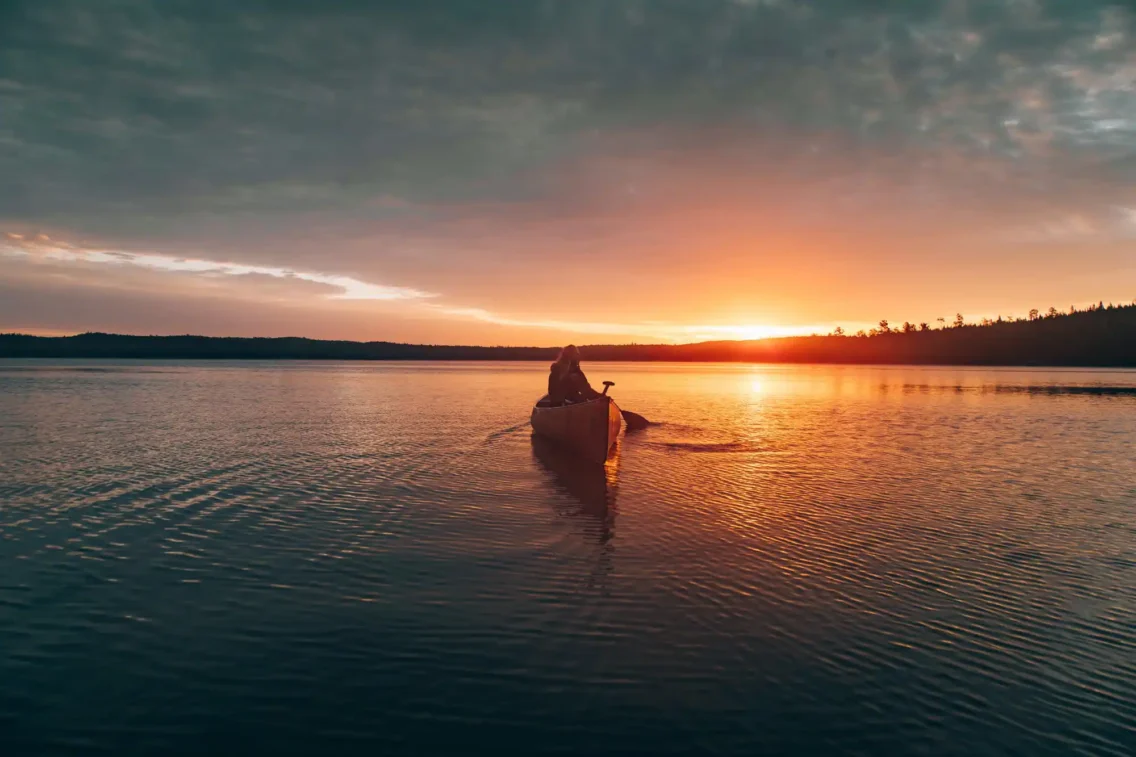Why Solo Kayaking Is the Perfect Escape for Introverts

Why Solo Kayaking Speaks to the Introvert’s Heart

Ever feel like the world is too loud, and you just want to hit pause? If you’ve been craving an activity that gives you peace of mind while keeping you active, solo kayaking might be exactly what you’re looking for. Unlike group sports that thrive on noise, competition, and constant interaction, kayaking alone gives you something priceless: control of your own energy.
You choose when to paddle, when to pause, and when to simply float and watch the water ripple around you. This is what makes solo kayaking so appealing to introverts. It is not just exercise for your body. It is a reset button for your mind.
The Quiet Power of Going Solo on the Water
Imagine pushing your kayak into a still lake at dawn. The world is asleep, the sky is brushed with soft light, and the only sound is your paddle breaking the surface. For introverts, this kind of quiet moment is not empty at all. It is nourishing.
Kayaking solo creates a rhythm that feels almost meditative. With every stroke, you let go of distractions and return to yourself. There are no group instructions to follow, no voices competing for your attention, no expectations to meet—just you and the steady pull of water.
When you kayak alone, you learn to trust yourself. You practice balance, steering, and safety. The first time you re-enter your kayak after tipping might feel awkward, but it teaches you that you are capable of handling challenges. Each outing adds a layer of resilience.
And here is the beauty: there is no one to judge your progress. You can paddle quickly if you feel energetic, or let the current carry you if you want rest. You can wobble, laugh at yourself, and try again. Unlike group adventures, you are not racing anyone, waiting for anyone, or comparing yourself to anyone.
Why Introverts Love It
So why does kayaking alone resonate so strongly with introverts? The benefits go beyond exercise, touching deeper aspects of independence and personal recharge.
- Personal pace. When you are kayaking solo, no one is setting the tempo but you. Want to glide slowly across calm waters while soaking in the scenery? Go for it. Prefer a stronger paddle to feel the burn and clear your head? That is your choice too. This freedom to move at your own rhythm is a rare gift, especially for introverts who often feel pressured to match the pace of others in group settings.
- Confidence builder. Every time you push off the shore alone, you prove to yourself that you are capable, adaptable, and resilient. Handling your kayak, navigating the water, and making decisions in real time all reinforce a sense of independence. For introverts who thrive on self-reliance, this confidence boost becomes more than just a sport—it spills into everyday life, reminding you that you can handle challenges on your own.
- True recharge. Unlike many social activities that can leave you drained, solo kayaking fills your energy tank. The quiet rhythm of paddling, the sounds of water, and the gentle isolation of nature all combine to restore clarity and calm. Instead of returning home exhausted, you come back refreshed and recharged—mentally lighter and emotionally stronger. For introverts, this is the kind of deep rest that makes life feel balanced again.
Think of it this way: solo kayaking is an adventure at your pace. It is meditation in motion, and every trip leaves you stronger both physically and emotionally.
Mental Health Benefits of Solo Nature Sports
Nature itself has a calming effect. According to UC Davis Health, simply being outdoors can shift your mental and physical state for the better. Fresh air, natural light, and the gentle rhythms of the environment lower cortisol, steady your breathing, and create a sense of ease that is hard to find indoors.
Now add kayaking to the mix, and those benefits multiply. Paddling keeps your body engaged while your mind unwinds. The focus on each stroke, the sway of the water, and the open surroundings turn a simple outing into an active form of stress relief and mindfulness.
For introverts, this is more than just exercise. Being alone on the water creates a personal sanctuary. The combination of solitude, movement, and nature gives you the rare chance to recharge fully, leaving you mentally clearer and emotionally lighter.
Why Kayaking Alone Is So Powerful for Your Mental Health
Beyond the science of being outdoors, kayaking itself has unique mental health benefits. Here’s how it works to clear your mind and strengthen your emotional balance:
- Reduces anxiety. One of the most calming aspects of solo kayaking is the way the steady, repetitive motion of paddling naturally draws your mind into the present. Instead of spiraling through racing thoughts, your brain focuses on the gentle pull and release of each stroke. This rhythm works like a calming flow, easing tension and helping you release daily worries. For introverts who often carry mental clutter, this quiet reset can feel life-changing.
- Encourages mindfulness. When you are on the water alone, every detail comes alive. The soft splash of the paddle, the ripple trailing behind your kayak, the sound of a bird overhead, even the feel of a cool breeze across your skin, all of it becomes part of a grounding experience. Solo kayaking is not just an exercise. It is an opportunity to cultivate awareness, allowing yourself to fully experience each moment without distraction.
- Builds resilience. Nature has a gentle way of teaching strength. Whether it is steering through a stronger current, adjusting to shifting weather, or simply trusting yourself to navigate back to shore, kayaking alone helps you build small victories in self-reliance. Over time, these small challenges add up. You leave the water not only refreshed but also more confident in your ability to handle life’s bigger challenges with calm and resilience.
If you have ever walked away from a crowded event feeling exhausted, solo kayaking is the opposite experience. The solitude of the water leaves you restored, not depleted.
Solo Kayaking vs. Solo Skiffs: Choosing Your Ride
When people think of going out alone on the water, two options often come up: solo kayaks and solo skiffs. Both are designed for one person, and both can give you a sense of independence, but they deliver very different experiences depending on what you are looking for.
Here’s a quick comparison to help you decide which one fits your style:
| Feature | Solo Kayak | Solo Riff |
| Power | Human-powered (paddle) | Motorized |
| Experience | Quiet, mindful, close to nature | Faster, more gear-focused, activity-oriented |
| Best For | Introverts, reflection, fitness, mindfulness | Anglers, photographers, exploring wide areas |
| Water Type | Calm lakes, gentle rivers, coastal bays | Larger lakes, open water, and fishing spots |
| Gear and Storage | Minimal, lightweight | More room for equipment and supplies |
| Connection to Nature | Feels immersive and intentional | More about activity than environment |
Bottom line:
- Choose a kayak if you value simplicity, mindfulness, and being part of the environment.
- Choose a skiff if you want speed, comfort, and space to focus on activities like fishing or exploring.
For introverts who value stillness and reflection, kayaks tend to offer a deeper sense of connection with nature than skiffs.
How to Stay Safe While Kayaking Alone
Safety becomes even more important when you kayak solo because there is no group to lean on if something goes wrong. That does not mean kayaking alone is dangerous. It simply means preparation is the key to freedom. When you know you are well-prepared, you can relax and fully enjoy the experience without unnecessary worry.
Here are some essential safety tips to keep in mind:
- Always wear a personal flotation device (life jacket). Even if you are a strong swimmer, a life jacket can be the difference between a close call and a serious accident. Think of it as your number-one non-negotiable gear.
- Check the weather forecast before heading out. Calm days with light winds are best for solo paddling. Avoid strong currents or storms that can make the water unpredictable.
- Tell someone your plan. Share where you are going and when you expect to return with a friend, family member, or even a neighbor. Having someone know your timeline adds an extra layer of safety.
- Pack the basics. Water, snacks, sunscreen, and a whistle are essentials. The whistle, in particular, is a simple but powerful tool to signal for help if needed.
- Stick to familiar waters when starting. Exploring new rivers or bays is exciting, but until you build confidence, it is best to paddle where you already know the currents, shoreline, and safe spots.
Remember, safety planning does not take away from the adventure. It does the opposite. It protects your freedom and gives you the confidence to fully immerse yourself in the water, the silence, and the serenity of solo kayaking. When you know you are safe, you are free to let go and simply enjoy the journey.
FAQs About Solo Kayaking
Do you need a license to kayak alone?
In most places, you do not need a license to kayak for recreational purposes. However, some areas may require permits for specific bodies of water, so it is best to check local regulations before heading out.
How to carry a kayak solo?
Carrying a kayak by yourself can be tricky at first, but technique makes it manageable. Stand beside the kayak, lift it onto your shoulder with the cockpit resting against you, and adjust the weight as you walk. If your kayak feels too heavy, choose a lighter model or invest in a kayak cart with wheels to make transport easier.
Can you fish from a solo kayak?
Yes, many solo kayaks are stable enough for fishing. Some are even designed with rod holders and storage space, making them a good option for those who want to combine solitude and sport.
Take the Paddle and Go
Solo kayaking is more than just a sport. It is a way to find peace, balance, and personal freedom in a noisy world. For introverts, it offers that rare combination of physical activity and restorative solitude.
So the next time you feel drained or overwhelmed, do not just retreat to the couch. Pick up a paddle, glide into the water, and let the quiet be your greatest adventure.


